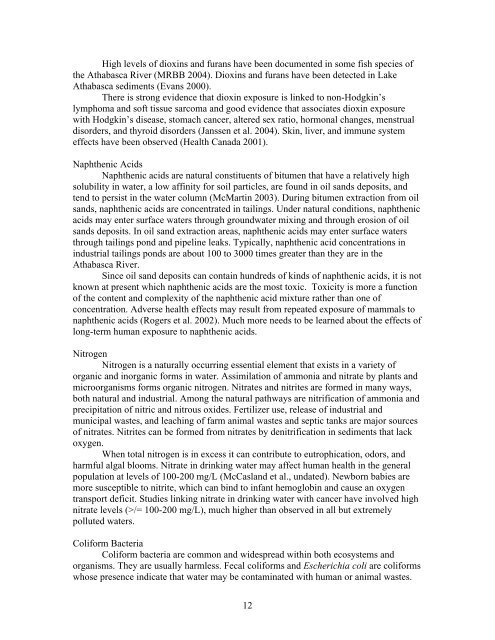A Study Of Water And Sediment Quality As - TO THE TAR SANDS .ca
A Study Of Water And Sediment Quality As - TO THE TAR SANDS .ca
A Study Of Water And Sediment Quality As - TO THE TAR SANDS .ca
You also want an ePaper? Increase the reach of your titles
YUMPU automatically turns print PDFs into web optimized ePapers that Google loves.
High levels of dioxins and furans have been documented in some fish species of<br />
the Athabas<strong>ca</strong> River (MRBB 2004). Dioxins and furans have been detected in Lake<br />
Athabas<strong>ca</strong> sediments (Evans 2000).<br />
There is strong evidence that dioxin exposure is linked to non-Hodgkin’s<br />
lymphoma and soft tissue sarcoma and good evidence that associates dioxin exposure<br />
with Hodgkin’s disease, stomach <strong>ca</strong>ncer, altered sex ratio, hormonal changes, menstrual<br />
disorders, and thyroid disorders (Janssen et al. 2004). Skin, liver, and immune system<br />
effects have been observed (Health Canada 2001).<br />
Naphthenic Acids<br />
Naphthenic acids are natural constituents of bitumen that have a relatively high<br />
solubility in water, a low affinity for soil particles, are found in oil sands deposits, and<br />
tend to persist in the water column (McMartin 2003). During bitumen extraction from oil<br />
sands, naphthenic acids are concentrated in tailings. Under natural conditions, naphthenic<br />
acids may enter surface waters through groundwater mixing and through erosion of oil<br />
sands deposits. In oil sand extraction areas, naphthenic acids may enter surface waters<br />
through tailings pond and pipeline leaks. Typi<strong>ca</strong>lly, naphthenic acid concentrations in<br />
industrial tailings ponds are about 100 to 3000 times greater than they are in the<br />
Athabas<strong>ca</strong> River.<br />
Since oil sand deposits <strong>ca</strong>n contain hundreds of kinds of naphthenic acids, it is not<br />
known at present which naphthenic acids are the most toxic. Toxicity is more a function<br />
of the content and complexity of the naphthenic acid mixture rather than one of<br />
concentration. Adverse health effects may result from repeated exposure of mammals to<br />
naphthenic acids (Rogers et al. 2002). Much more needs to be learned about the effects of<br />
long-term human exposure to naphthenic acids.<br />
Nitrogen<br />
Nitrogen is a naturally occurring essential element that exists in a variety of<br />
organic and inorganic forms in water. <strong>As</strong>similation of ammonia and nitrate by plants and<br />
microorganisms forms organic nitrogen. Nitrates and nitrites are formed in many ways,<br />
both natural and industrial. Among the natural pathways are nitrifi<strong>ca</strong>tion of ammonia and<br />
precipitation of nitric and nitrous oxides. Fertilizer use, release of industrial and<br />
municipal wastes, and leaching of farm animal wastes and septic tanks are major sources<br />
of nitrates. Nitrites <strong>ca</strong>n be formed from nitrates by denitrifi<strong>ca</strong>tion in sediments that lack<br />
oxygen.<br />
When total nitrogen is in excess it <strong>ca</strong>n contribute to eutrophi<strong>ca</strong>tion, odors, and<br />
harmful algal blooms. Nitrate in drinking water may affect human health in the general<br />
population at levels of 100-200 mg/L (McCasland et al., undated). Newborn babies are<br />
more susceptible to nitrite, which <strong>ca</strong>n bind to infant hemoglobin and <strong>ca</strong>use an oxygen<br />
transport deficit. Studies linking nitrate in drinking water with <strong>ca</strong>ncer have involved high<br />
nitrate levels (>/= 100-200 mg/L), much higher than observed in all but extremely<br />
polluted waters.<br />
Coliform Bacteria<br />
Coliform bacteria are common and widespread within both ecosystems and<br />
organisms. They are usually harmless. Fe<strong>ca</strong>l coliforms and Escherichia coli are coliforms<br />
whose presence indi<strong>ca</strong>te that water may be contaminated with human or animal wastes.<br />
12


